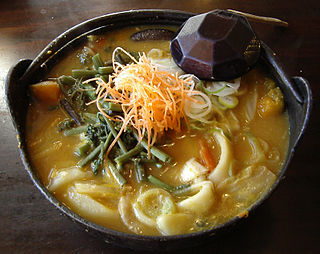 W
WThis is a list of Japanese soups and stews. Japanese cuisine is the food—ingredients, preparation and way of eating—of Japan. The phrase ichijū-sansai refers to the makeup of a typical meal served, but has roots in classic kaiseki, honzen, and yūsoku cuisine. The term is also used to describe the first course served in standard kaiseki cuisine nowadays.
 W
WButajiru or tonjiru is a Japanese soup made with pork and vegetables, flavoured with miso. It is a more substantial version of miso soup, with a larger quantity and variety of ingredients.
 W
WChankonabe (ちゃんこ鍋) is a Japanese stew commonly eaten in vast quantity by sumo wrestlers as part of a weight-gain diet.
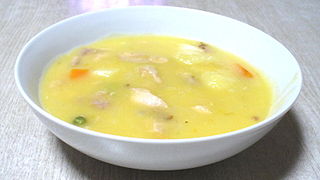 W
WCream stew is a popular Yōshoku dish consisting of meat, usually chicken or pork, and mixed vegetables, onion, carrot, potato and cabbage, cooked in thick white roux. The vegetables are sauteed before the meat is added with some water. The surface fats are removed by degreasing and then the roux is added. It is common in Japan to use ready-made roux, as for making Japanese curry, which comes in a block from a box. The roux though can also be cooked from scratch. The hard paste roux melts from the heat and blends with the water to create a thick stew. Milk can also be used as replacement for water, to make the stew more creamy.
 W
WDojo nabe is a Japanese nabemono dish. To prepare the dish, pond loaches are cooked in a hot pot. The freshwater fishes are either killed ahead of cooking or are first soaked in cold sake and then cooked alive.
 W
WFugu chiri is a pufferfish soup. It is also known as tetchiri.
 W
WHari-hari nabe (はりはり鍋) is a type of nabemono made with minke whale meat and mizuna. It is mainly found in the Kansai region, mostly in the Osaka metropolitan area. The name "harihari" is onomatopoeic and refers to the sound of chewing mizuna.
 W
WHot and sour soup is a soup from Asian culinary traditions. In all cases, the soup contains ingredients to make it both spicy and sour.
 W
WHōtō (ほうとう) is a noodle soup and popular regional dish originating from Yamanashi, Japan made by stewing flat udon noodles and vegetables in miso soup. Though hōtō is commonly recognized as a variant of udon, locals do not consider it to be an udon dish because the dough is prepared in the style of dumplings rather than noodles.
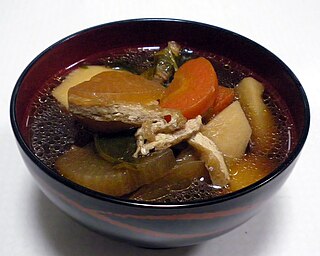 W
WKenchin jiru, also spelled kenchin-jiru, and sometimes referred to simply as kenchin, is a Japanese vegetable soup prepared using root vegetables and tofu. It is a popular dish in Japan and is prepared in various manners using myriad ingredients. It has been stated that the dish originated several centuries ago from Kenchō-ji, a temple, and it has also been suggested that the dish has its roots in shippoku cuisine.
 W
WKiritanpo (きりたんぽ) is a Japanese dish particularly in Akita Prefecture. Freshly cooked rice is pounded until somewhat mashed, then formed into cylinders around Japanese cedar skewers, and toasted over an open hearth. It can then be served with sweet miso or cooked as dumplings with meat and vegetables in soups.
 W
WMiso soup is a traditional Japanese soup consisting of a dashi stock into which softened miso paste is mixed. In addition, there are many optional ingredients that may be added depending on regional and seasonal recipes, and personal preference. In Japanese food culture, Miso soup is a representative of soup dishes served with rice. Miso soup is also called Omiotsuke (御味御付).
 W
WMotsunabe (もつ鍋) is a type of nabemono in Japanese cuisine, which is made from beef or pork tripe or other offal. It is a popular stew made with guts portions of various types of meat, prepared in a conventional kitchen cooking pot or a special Japanese nabe pot (nabe). When it is cooked, it is filled with soup, prepared beef or pork offal and boiled for a while; cabbage and garlic chives are added. The base soup is usually soy sauce with garlic and chili pepper, or miso. Champon noodles are often put into the pot and boiled to complete the dish. The offal used in motsunabe is mostly beef intestines, but various kinds of offal can be used.
 W
WNabemono, or simply nabe, is a variety of Japanese hot pot dishes, also known as one pot dishes and "things in a pot".
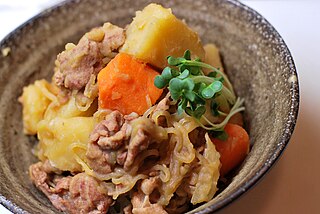 W
WNikujaga is a Japanese dish of meat, potatoes and onion stewed in sweetened soy sauce and mirin, sometimes with ito konnyaku and vegetables. Nikujaga is an example of yōshoku. Generally, potatoes make up the bulk of the dish, with meat mostly serving as a source of flavor. It is usually boiled until most of the liquid has been reduced. Thinly sliced beef is the most common meat used, although minced or ground beef is also popular. Pork is often used instead of beef in eastern Japan.
 W
WNimono is a simmered dish in Japanese cuisine. A nimono generally consists of a base ingredient simmered in shiru stock & seasoned with sake, soy sauce, and a small amount of sweetening. The nimono is simmered in the shiru over a period of time until the liquid is absorbed into the base ingredient or evaporated. The base ingredients for a nimono is typically a vegetable, fish, seafood, or tofu, either singly, or in combination. The shiru stock for a nimono is generally dashi. Other than sake and soy sauce, the stock can be further flavored by mirin, sugar, salt, vinegar, miso, or other condiments.
 W
WOden is a type of nabemono, consisting of several ingredients such as boiled eggs, daikon, konjac, and processed fishcakes stewed in a light, soy-flavored dashi broth.
 W
WOhaw or rur is a savory soup of the Ainu people of northern Japan, flavored with fish or animal bones. Kelp is also used to add flavor to the stock. Unlike the majority of the traditional Japanese soups, the Ainu do not use miso or soy sauce in their soups. The solid ingredients such as meat, fish, vegetables and/or wild edible plants are added to the stock.
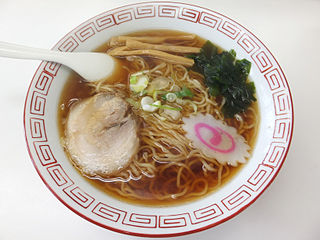 W
WRamen is a Japanese noodle soup. It consists of Chinese-style wheat noodles served in a meat or (occasionally) fish-based broth, often flavored with soy sauce or miso, and uses toppings such as sliced pork , nori, menma, and scallions. Nearly every region in Japan has its own variation of ramen, such as the tonkotsu ramen of Kyushu, and the miso ramen of Hokkaido. Mazemen is a ramen dish that is not served in a soup, but rather with a sauce.
 W
WShabu-shabu is a Japanese nabemono hotpot dish of thinly sliced meat and vegetables boiled in water and served with dipping sauces. The term is onomatopoeic, derived from the sound – "swish swish" – emitted when the ingredients are stirred in the cooking pot. The food is cooked piece by piece by the diner at the table. Shabu-shabu is considered to be more savory and less sweet than sukiyaki.
 W
WSukiyaki is a Japanese dish that is prepared and served in the nabemono style.
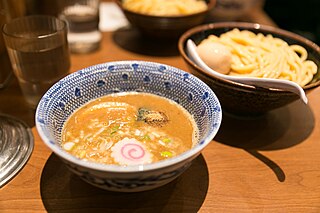 W
WTsukemen is a ramen dish in Japanese cuisine consisting of noodles which are eaten after being dipped in a separate bowl of soup or broth. The dish was invented in 1961 by Kazuo Yamagishi, a restaurateur in Tokyo, Japan, after which it has become a very popular dish in Tokyo and throughout Japan. In the United States, tsukemen has become popular in Los Angeles, while it remains relatively uncommon in other American cities.
 W
WZōni , often with the honorific "o-" as o-zōni, is a Japanese soup containing mochi rice cakes. The dish is strongly associated with the Japanese New Year and its tradition of osechi ceremonial foods. The preparation of zōni varies both by household and region.
 W
WZōsui , or ojiya (おじや), is a mild and thin Japanese rice soup akin to a rice-based vegetable soup. It is made from pre-cooked rice and dashi or water seasoned with either soy sauce or miso and cooked with other ingredients such as meat, seafood, mushrooms, and vegetables. It is generally served to those who are sick or otherwise feeling unwell, and is usually only served in the winter.